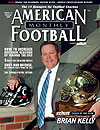Article CategoriesAFM Magazine
|
Schutt - National High School Coach of the Yearby: Mike KucharSenior Writer, American Football Monthly © More from this issue Coaching Smart A Florida football legend, George Smith, is the Schutt Sports National High School Coach of the Year George Smith’s coaching career could have ended before it ever really got started. As a 27-year-old first-year head coach, Smith was getting his staff together after his first full season, a 6-4 campaign in 1975. “I was going around asking my staff in a post-season meeting who was going to come back for next year,” Smith recalls. “They all looked at me and said ‘we’re not coming back because you did everything. You didn’t need us.’” Within five minutes, Smith learned his first valuable coaching lesson – trust your coaches and learn how to delegate.
|
|
|||||||
| HOME |
MAGAZINE |
SUBSCRIBE | ONLINE COLUMNISTS | COACHING VIDEOS |
Copyright 2025, AmericanFootballMonthly.com
All Rights Reserved





